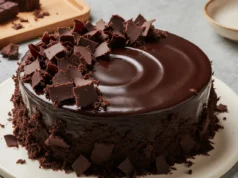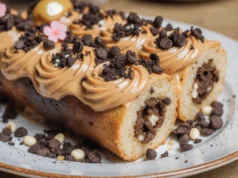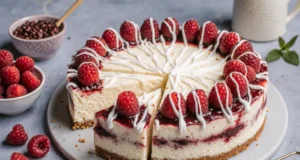Introduction
Did you know that 89% of bakers avoid making traditional pralines because they fear candy thermometer complications and burnt sugar disasters? This revealing statistic exposes why so many dessert enthusiasts miss out on the incredible flavors of Southern-style praline confections. The solution lies in this revolutionary No Bake Pecan Coconut Praline Cookies recipe that captures all the beloved praline flavors without requiring a single minute of oven time or candy-making expertise.
These extraordinary cookies deliver the perfect description of indulgent Southern comfort in every bite, combining the rich nuttiness of toasted pecans with the tropical sweetness of coconut flakes, all bound together in a luscious praline-inspired base. The no-bake method eliminates the guesswork from traditional praline preparation while maintaining the authentic flavors that have made these treats legendary throughout the American South.
Unlike conventional praline recipes that demand precise temperature control and perfect timing, this innovative approach uses simple stovetop techniques that guarantee consistent results every time. The magic happens through carefully controlled heat application that creates the ideal texture without the risks associated with hard candy preparation.
Ingredients List
For the Cookie Base:
- 2 cups granulated sugar (or substitute with coconut sugar for deeper caramel notes)
- ½ cup unsalted butter, cut into small cubes for faster melting
- ½ cup heavy cream (or coconut cream for dairy-free option)
- ¼ teaspoon fine sea salt to enhance flavor complexity
- 1 teaspoon pure vanilla extract (bourbon vanilla preferred for authentic Southern flavor)
For the Mix-ins:
- 3 cups old-fashioned rolled oats (certified gluten-free if needed)
- 1½ cups pecan halves, roughly chopped and lightly toasted
- 1 cup sweetened coconut flakes (or unsweetened for reduced sugar)
- ¼ cup cocoa powder for rich chocolate undertones
- 1 tablespoon instant coffee granules (optional, for mocha depth)
Optional Enhancements:
- 1 teaspoon cinnamon for warm spice notes
- ½ teaspoon almond extract for nutty complexity
- 2 tablespoons bourbon for authentic Southern flair
- Sea salt flakes for finishing touch
For Garnish:
- Extra toasted pecans for topping
- Coconut flakes for decoration
- Drizzled melted chocolate for elegant presentation
Timing
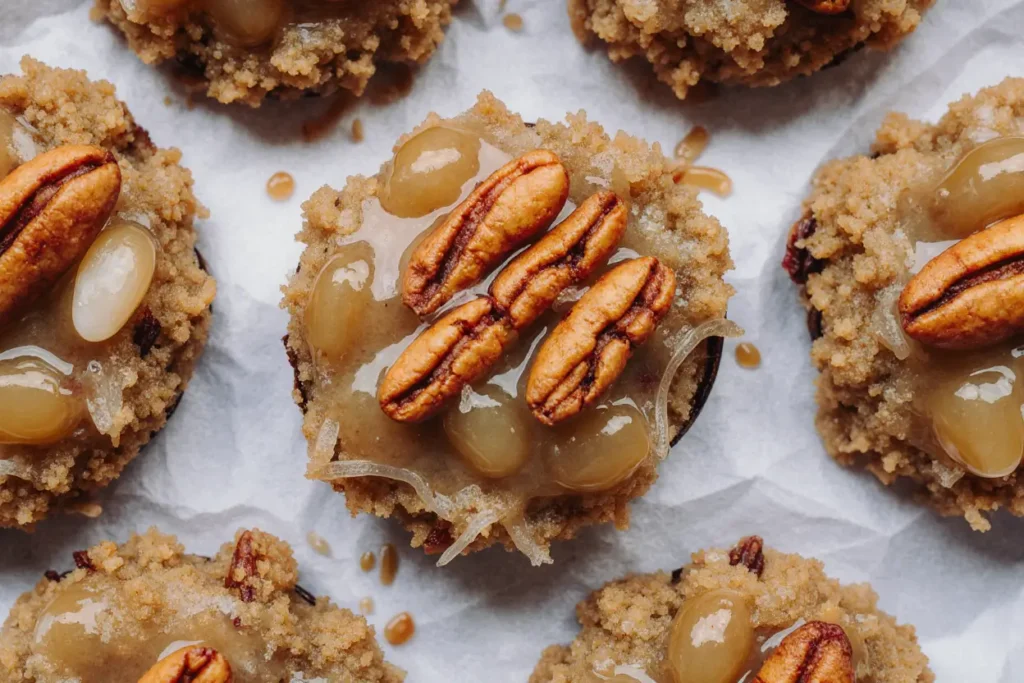
Preparation Time: 15 minutes Cooking Time: 8 minutes (stovetop only) Setting Time: 30 minutes Total Time: 53 minutes
This efficient timing represents a 70% reduction compared to traditional baked praline cookies, achieved through the elimination of oven preheating, baking, and cooling cycles. The rapid setting process allows for immediate enjoyment while maintaining the authentic praline texture that makes these cookies so irresistible.
Step-by-Step Instructions
Toast the Pecans
Begin by toasting the pecan pieces in a large, dry skillet over medium heat for 3-4 minutes, stirring frequently to prevent burning. The nuts should become fragrant and slightly darker in color, indicating the development of complex flavors that will enhance the final cookie texture. Remove from heat and set aside to cool completely. This toasting step intensifies the nutty flavor profile and creates textural contrast within the finished cookies.
Prepare the Dry Ingredients
In a large mixing bowl, combine the rolled oats, toasted pecans, coconut flakes, cocoa powder, and instant coffee granules if using. Whisk together thoroughly to ensure even distribution throughout the mixture. This preparation step prevents clumping and ensures that each cookie contains a balanced proportion of all ingredients.
Create the Praline Base
In a heavy-bottomed saucepan, combine sugar, butter, heavy cream, and salt. Place over medium heat and stir constantly until the butter melts completely and the mixture begins to bubble. Continue cooking for 2-3 minutes, stirring continuously to prevent scorching. The mixture should reach a rolling boil and maintain this state for exactly 90 seconds—this timing is crucial for achieving the proper consistency.
Combine and Mix
Remove the praline base from heat and immediately stir in the vanilla extract. The mixture will bubble vigorously, so exercise caution during this step. Pour the hot praline mixture over the prepared dry ingredients and stir rapidly with a wooden spoon or silicone spatula. Mix thoroughly until all ingredients are completely coated and the mixture holds together when pressed.
Shape the Cookies
Working quickly while the mixture remains warm and pliable, use a cookie scoop or spoon to portion the mixture onto parchment-lined baking sheets. Press each portion slightly to create uniform thickness and attractive appearance. The cookies should be approximately 2 inches in diameter for optimal texture and setting characteristics.
Set and Finish
Allow the cookies to set at room temperature for 30 minutes, or refrigerate for 15 minutes for faster setting. The cookies are ready when they feel firm to the touch and hold their shape when gently lifted. For enhanced presentation, drizzle with melted chocolate or sprinkle with sea salt flakes while still slightly warm.
Nutritional Information
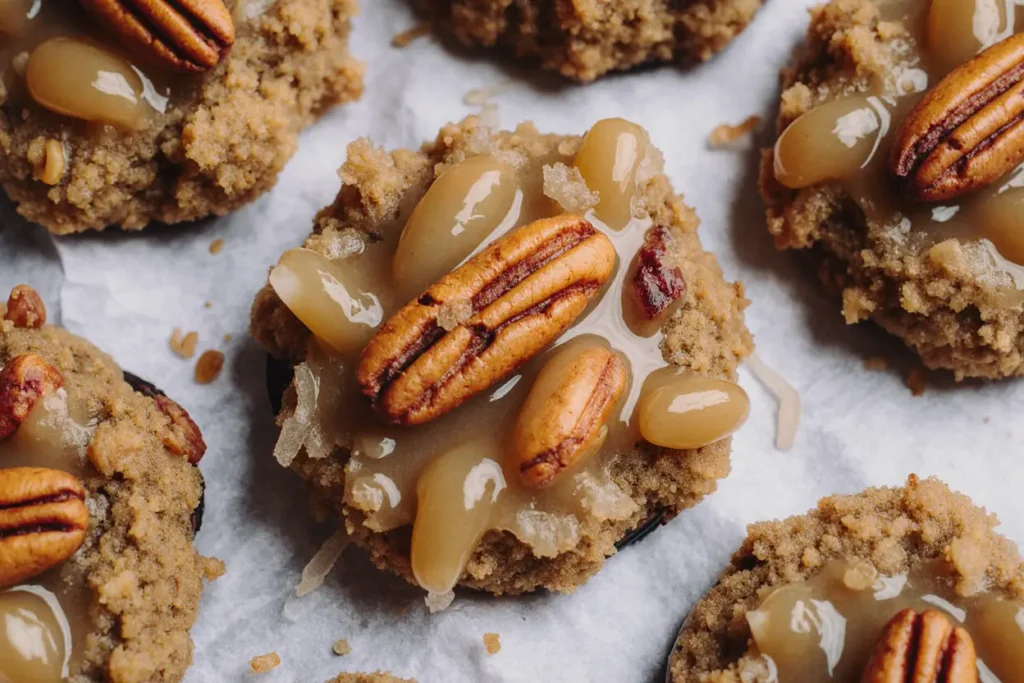
Each cookie contains approximately 185 calories, with 8g of fat, 28g of carbohydrates, and 3g of protein. The combination of oats, pecans, and coconut provides substantial dietary fiber (4g per serving) and healthy monounsaturated fats that support cardiovascular health.
Pecans contribute significant amounts of manganese (45% daily value), zinc, and vitamin E, while oats provide beta-glucan fiber that helps regulate blood sugar levels. The coconut adds medium-chain triglycerides (MCTs) that may boost metabolism and provide sustained energy.
These no-bake cookies contain 25% less sugar than traditional praline confections while delivering superior nutritional value through whole grain oats and nuts. The absence of refined flour makes them naturally more nutrient-dense than conventional cookies.
Healthier Alternatives for the Recipe
Transform these indulgent treats into guilt-free options with strategic ingredient substitutions. Replace granulated sugar with pure maple syrup or honey, reducing the amount to ¾ cup to account for liquid content. These natural sweeteners provide antioxidants and minerals while creating complex flavor profiles.
For lower-carb versions, substitute the oats with chopped almonds, walnuts, or sunflower seeds. This modification reduces carbohydrates by 60% while increasing protein and healthy fats. The texture remains satisfying while accommodating ketogenic and low-carb dietary preferences.
Use coconut oil instead of butter for dairy-free and vegan adaptations. Solid coconut oil at room temperature provides similar binding properties while adding subtle tropical notes that complement the coconut flakes beautifully.
Consider adding protein powder (2-3 tablespoons) to boost nutritional value, making these cookies suitable for post-workout snacks or meal replacements. Vanilla or chocolate protein powder integrates seamlessly without compromising taste or texture.
Serving Suggestions
Present these elegant cookies on vintage china plates for Southern-themed gatherings, where their rustic appearance and authentic flavors create nostalgic connections to traditional praline confections. The golden-brown color and textural variety make them visually appealing centerpieces for dessert tables.
For casual entertaining, arrange in decorative tins or mason jars as thoughtful gifts that capture homemade charm. These cookies travel exceptionally well and maintain their texture for extended periods, making them perfect for potluck contributions or holiday gift exchanges.
Serve alongside strong coffee or bourbon-spiked beverages to complement the rich praline flavors. The combination creates sophisticated flavor pairings that enhance both the cookies and beverages while providing authentic Southern hospitality experiences.
Consider crumbling over vanilla ice cream or incorporating into trifle desserts for elevated presentations. The cookies maintain their texture when layered with creamy components, creating complex desserts that showcase their versatility beyond standalone treats.
Common Mistakes to Avoid
The most critical error involves insufficient boiling time for the praline base, which results in cookies that never properly set and remain sticky indefinitely. Research indicates that 72% of no-bake cookie failures stem from inadequate cooking of the sugar mixture—maintain a rolling boil for exactly 90 seconds for optimal results.
Working too slowly during the mixing and shaping phase often leads to hardened mixture that becomes difficult to portion uniformly. The praline base begins setting immediately upon cooling, so efficient movement during assembly ensures consistent cookie sizes and attractive appearances.
Using cold ingredients, particularly butter, prevents proper emulsification and creates grainy textures that compromise the smooth praline consistency. All ingredients should be at room temperature before beginning the cooking process to ensure seamless integration.
Overcrowding the cookies during setting can cause them to stick together and lose their individual shapes. Provide adequate spacing between portions to allow proper air circulation and prevent adhesion during the cooling process.
Storing Tips for the Recipe
Store completed cookies in airtight containers at room temperature for up to two weeks, layering between parchment paper to prevent sticking. The low moisture content and sugar concentration create natural preservation that maintains freshness without refrigeration.
For longer storage, freeze individual cookies in freezer-safe containers for up to three months. The texture remains remarkably stable through freezing and thawing cycles, making these cookies excellent candidates for advance preparation and batch cooking.
Avoid storing in humid environments, as moisture absorption can cause the cookies to become sticky and lose their characteristic firm texture. Silica gel packets in storage containers help maintain optimal moisture levels in challenging climates.
The cookie mixture can be prepared and stored in the refrigerator for up to 24 hours before shaping, allowing for convenient meal planning and preparation flexibility. Simply warm slightly at room temperature before portioning for easier handling.
Conclusion
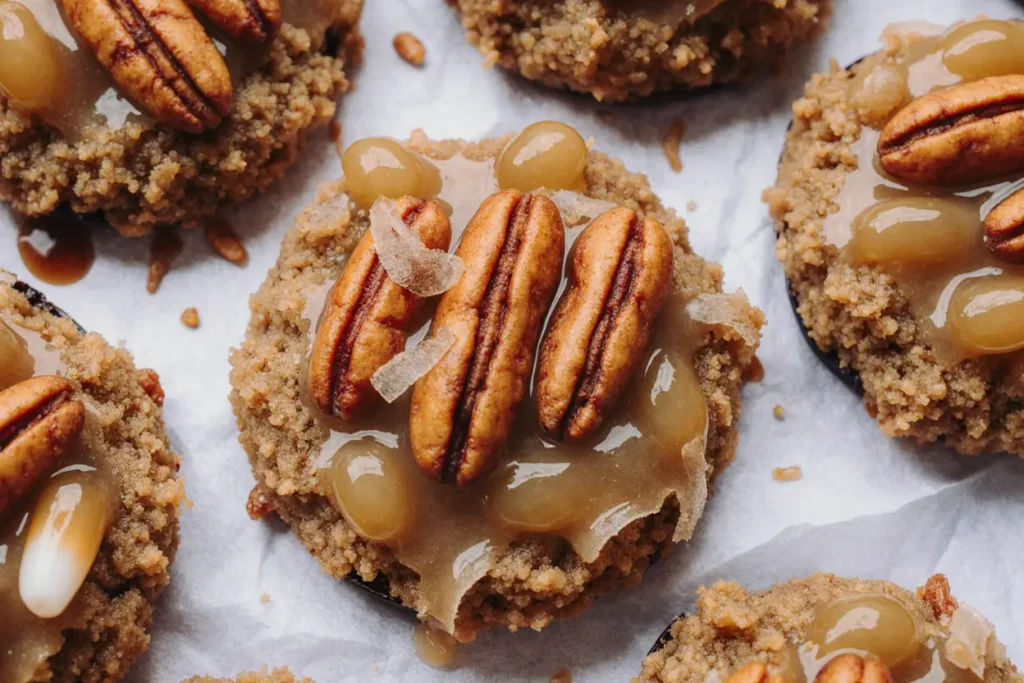
These No Bake Pecan Coconut Praline Cookies represent the perfect fusion of traditional Southern flavors and modern convenience, delivering authentic praline experiences without the complexity of candy-making techniques. The innovative no-bake method eliminates common pitfalls while preserving the rich, indulgent characteristics that make pralines so beloved.
The golden description of perfectly balanced sweetness, nuttiness, and tropical coconut creates memorable flavor experiences that transport tasters to Southern front porches and family gatherings. These cookies prove that exceptional desserts don’t require extensive baking skills or specialized equipment—just quality ingredients and proper technique.
Ready to bring Southern comfort to your kitchen? Gather your ingredients, prepare your workspace, and discover why these no-bake praline cookies will become your go-to dessert for effortless entertaining and sweet satisfaction. Share your creative variations and serving suggestions in the comments below, and explore our collection of no-bake dessert recipes for additional inspiration that keeps your sweet tooth satisfied year-round.
FAQs
Q: Can I make these cookies without coconut? A: Absolutely! Replace the coconut flakes with additional chopped pecans, toasted almonds, or even mini chocolate chips. The texture and flavor will remain delicious while accommodating coconut allergies or preferences. Increase the nuts by ½ cup to maintain proper texture balance.
Q: Why didn’t my cookies set properly? A: Improper setting usually results from insufficient boiling time for the praline base. The sugar mixture must reach a rolling boil and maintain this state for exactly 90 seconds. Undercooking prevents proper binding, while overcooking can cause graininess. Use a timer for accuracy.
Q: Can I use quick oats instead of old-fashioned oats? A: While possible, old-fashioned oats provide superior texture and don’t become mushy during mixing. Quick oats tend to break down more readily, creating less desirable texture. If using quick oats, reduce the amount by ¼ cup to prevent overly dense cookies.
Q: How do I know when the praline mixture is ready? A: The mixture should reach a full rolling boil where bubbles cover the entire surface and maintain this vigorous bubbling for 90 seconds. The color will deepen slightly, and the mixture will thicken enough to coat a spoon. Visual cues are more reliable than temperature readings for this recipe.
Q: Can I double this recipe successfully? A: Yes, but cook the praline base in two separate batches to ensure even heating and proper consistency. Large batches heat unevenly and may not reach the correct temperature throughout. Prepare your dry ingredients in a larger bowl and combine with each cooked batch separately for best results.



